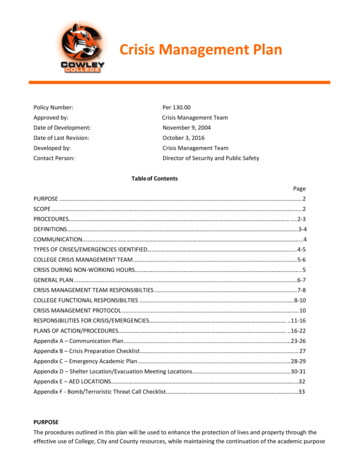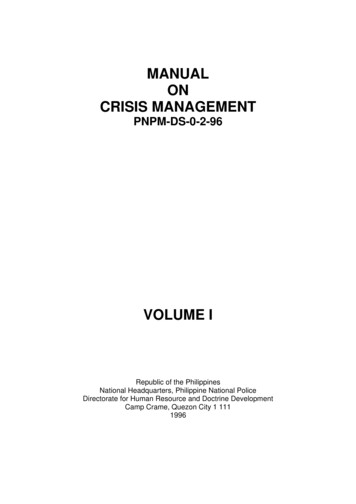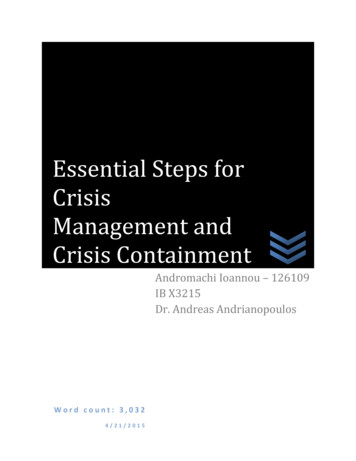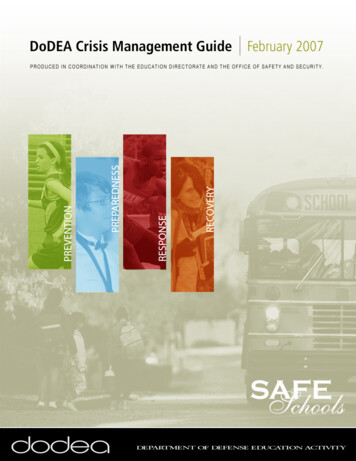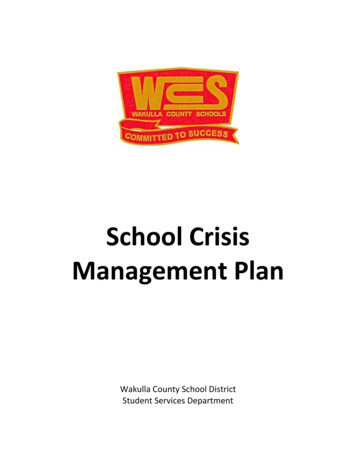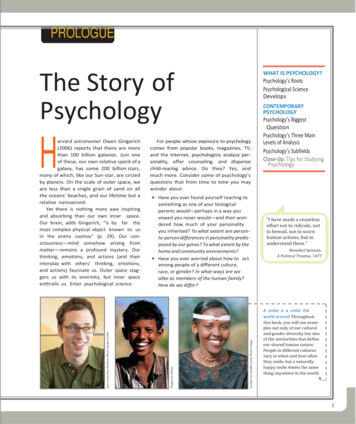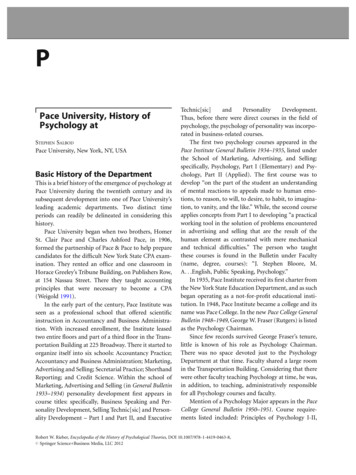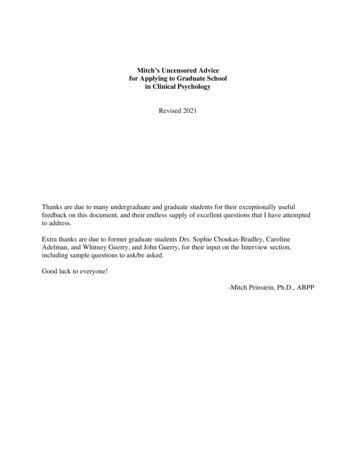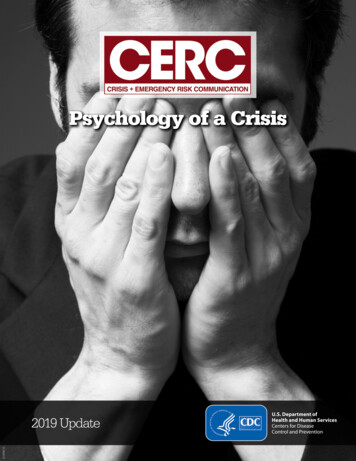
Transcription
Psychology of a Crisis2019 UpdateCS 290397-E
CERC: Psychology of a CrisisExplanations of figures for accessibility found in the Appendix: Accessible Explanation of Figures on page 16.This chapter will introduce:Four Ways People Process Information During a CrisisMental States in a CrisisBehaviors in a CrisisNegative Vicarious RehearsalAddressing Psychology in the CERC RhythmCrises, emergencies, and disasters happen. Disastersare different from personal and family emergencies,and not just because they are larger in scale. Disastersthat take a toll on human life are characterized bychange, high levels of uncertainty, and complexity.1In a crisis, affected people take in information,process information, and act on informationdifferently than they would during non-crisistimes.2,3 People or groups may exaggerate theircommunication responses. They may revert to morebasic or instinctive fight-or-flight reasoning.Effective communication during a crisis is notan attempt at mass mental therapy, nor is it a magic2potion that fixes all problems. Nonetheless, to reducethe psychological impact of a crisis, the public shouldfeel empowered to take actions that will reduce theirrisk of harm.This chapter will briefly describe how peopleprocess information differently during a crisis, themental states and behaviors that tend to emerge incrises, how psychological effects are different in eachphase of a crisis, and how to communicate to bestreach people during these changing states of mind.CERC: Psychology of a Crisis
Four Ways People Process Informationduring a CrisisBy understanding how people take in information during a crisis state, we can better plan to communicatewith them. During a crisis:We simplify messages.4 Misinterpreting confusing action messages.Under intense stress and possible informationoverload, we tend to miss the nuances of healthand safety messages by doing the following:To cope, many of us may not attempt a logical andreasoned approach to decision making. Instead, wemay rely on habits and long-held practices. We mightfollow bad examples set by others. Not fully hearing information because of ourinability to juggle multiple facts during a crisis. Not remembering as much of the information aswe normally could.Use simple messages.We hold on to current beliefs.5,6Crisis communication sometimes requires askingpeople to do something that seems counterintuitive,such as evacuating even when the weatherlooks calm.Changing our beliefs during a crisis or emergencymay be difficult. Beliefs are often held very stronglyand not easily altered. We tend not to seek evidencethat contradicts beliefs we already hold.We also tend to exploit any conflicting orunclear messages about a subject by interpretingit as consistent with existing beliefs. For example,we might tell ourselves, “I believe that my house is asafe place.” Before an impending hurricane, however,experts may recommend that we evacuate froman insecure location and take shelter in a buildingthat is stronger and safer. Although the actionadvised is actually for us to evacuate our house toseek a safer shelter, we can easily misinterpret therecommendation to match our current beliefs. Wemight say, “My home is strong and safe. I’ve alwaysbeen secure in my home. When we left last time, thehurricane went north of us anyway. I’ll just stay here.”Faced with new risks in an emergency, we mayhave to rely on experts with whom we have littleor no experience. Often, reputable experts disagreeregarding the level of threat, risks, and appropriateadvice. The tendency of experts to offer opposingviews leaves many of us with increased uncertaintyand fear. We may be more likely to take advice from atrusted source with which we are familiar, even if thissource does not have emergency-related expertiseand provides inaccurate information.Messages should come from a credible source.3CERC: Psychology of a Crisis
We look for additional information and opinions.7,8We remember what we see and tend to believe whatwe’ve experienced. During crises, we want messagesconfirmed before taking action. You may find thatyou or other individuals are likely to do the following: Change television channels to see if the samewarning is being repeated elsewhere. Try to call friends and family to see if others haveheard the same messages. Turn to a known and credible local leader foradvice. Check multiple social media channels to see whatour contacts are saying.In cases where evacuation is recommended, we tendto watch to see if our neighbors are evacuating beforewe make our decision. This confirmation first—beforewe take action—is very common in a crisis.Use consistent messages.We believe the first message.9During a crisis, the speed of a response can be animportant factor in reducing harm. In the absenceof information, we may begin to speculate and fillin the blanks. This often results in rumors. The firstmessage to reach us may be the accepted message,even though more accurate information may follow.When new, perhaps more complete informationbecomes available, we compare it to the firstmessages we heard.Because of the ways we process information whileunder stress, when communicating with someonefacing a crisis or disaster, messages should besimple, credible, and consistent. Speed is also veryimportant when communicating in an emergency. Aneffective message must do the following: Be repeated.Come from multiple credible sources.Be specific to the emergency being experienced.Offer a positive course of action that canbe executed.Release accurate messages as soon as possible.4CERC: Psychology of a Crisis
Mental States in a CrisisDuring a disaster, people may experience a widerange of emotions. Psychological barriers caninterfere with cooperation and response from thepublic. Crisis communicators should expect certainpatterns, as described below, and understand thatthese patterns affect communication.There are a number of psychological barriersthat could interfere with cooperation and responsefrom the public. A communicator can mitigatemany of the following reactions by acknowledgingthese feelings in words, expressing empathy, andbeing honest.UncertaintyUnfortunately, there are more questions thananswers during a crisis, especially in the beginning.At that time, the full magnitude of the crisis, thecause of the disaster, and the actions that peoplecan take to protect themselves may be unclear.This uncertainty will challenge even the greatestcommunicator.To reduce their anxiety, people seek outinformation to determine their options and confirmor disconfirm their beliefs. They may choose afamiliar source of information over a less familiarsource, regardless of the accuracy of the providedinformation.7 They may discount information that isdistressing or overwhelming.Many communicators and leaders have beentaught to sound confident even when they areuncertain. While this may inspire trust, there is apotential for overconfidence, which can backfire. It isimportant to remember that an over-reassured publicisn’t the goal. You want people to be concerned,remain vigilant, and take all the right precautions.Acknowledge uncertainty. Acknowledge andexpress empathy for your audience’s uncertaintyand share with them the process you are using toget more information about the evolving situation.This will help people to manage their anxiety. Usestatements such as, “I can’t tell you today what’s5causing people in our town to die so suddenly, but Ican tell you what we’re doing to find out. Here’s thefirst step ”Tell them What you know. What you don’t know. What process you are using to get answers.Although we can hope for certain outcomes, weoften cannot promise that they will occur. Instead ofoffering a promise outside of your absolute control,such as “we’re going to catch the evil people whodid this,” promise something you can be sure thatresponse officials will do, such as “we’re going tothrow everything we have at catching the bad guys,or stopping the spread of disease, or preventingfurther flood damage.”Former New York City Mayor Rudolph Giulianicautioned, “Promise only when you’re positive. Thisrule sounds so obvious that I wouldn’t mention itunless I saw leaders break it on a regular basis.”10 Adanger early in a crisis, especially if you’re responsiblefor fixing the problem, is to promise an outcomeoutside your control. Never make a promise, nomatter how heartfelt, unless it’s in your absolutepower to deliver.CERC: Psychology of a Crisis
Fear, Anxiety, and DreadIn a crisis, people in your community may feelfear, anxiety, confusion, and intense dread. Ascommunicators, our job is not to make these feelingsgo away. Instead, you could acknowledge them in astatement of empathy. You can use a statement like,“we’ve never faced anything like this before in ourcommunity and it can be frightening.”Fear is an important psychological considerationin the response to a threat. Bear in mind thefollowing aspects of fear: In some cases, a perceived threat can motivate andhelp people take desired actions. In other cases, fear of the unknown or fear ofuncertainty may be the most debilitating of thepsychological responses to disasters and preventpeople from taking action. When people are afraid, and do not have adequateinformation, they may react in inappropriate waysto avoid the threat.Communicators can help by portraying an accurateassessment of the level of danger and providing actionmessages so that affected people do not feel helpless.Hopelessness and HelplessnessAvoiding hopelessness and helplessness is avital communication objective during a crisis.Hopelessness is the feeling that nothing can bedone by anyone to make the situation better. Peoplemay accept that a threat is real, but that threat mayloom so large that they feel the situation is hopeless.Helplessness is the feeling that people have thatthey, themselves, have no power to improve theirsituation or protect themselves. If a person feelshelpless to protect him- or herself, he or she maywithdraw mentally or physically.According to psychological research, ifcommunity members let their feelings of fear,anxiety, confusion, and dread grow uncheckedduring a crisis, they will most likely begin to feelhopeless or helpless.11 If this happens, community6members will be less motivated and less able to takeactions that could help themselves.Instead of trying to eliminate a community’semotional responses to the crisis, help communitymembers manage their negative feelings bysetting them on a course of action. Taking anaction during a crisis can help to restore a sense ofcontrol and overcome feelings of hopelessness andhelplessness.11 Helping the public feel empoweredand in control of at least some parts of their lives mayalso reduce fear.As much as possible, advise people to takeactions that are constructive and directly relate to thecrisis they’re facing. These actions may be symbolic,such as putting up a flag or preparatory, such asdonating blood or creating a family check-in plan.CERC: Psychology of a Crisis
DenialDenial refers to the act of refusing to acknowledgeeither imminent harm or harm that has alreadyoccurred. Denial occurs for a variety of reasons: People may not have received enough informationto recognize the threat. They may assume the situation is not as bad asit really is because they have not heard the mostrecent warnings, didn’t understand what they weretold, or only heard part of a message. They may have received messages about a threatbut not received action messages on how peopleshould respond to the threat. They may receive and understand the message,but behave as if the danger is not as greatas they are being told. For example, peoplemay get tired of evacuating for threats thatprove harmless, which can cause people todeny the seriousness of future threats.When people doubt a threat is real, they may seekfurther confirmation. With some communities, thisconfirmation may involve additional factors, such asthe following: A need to consult community leaders or expertsfor specific opinions. The desire to first know how others are responding. The possibility that the warning message of thethreat is so far outside the person’s experience thathe or she simply can’t make sense of it—or justchooses to ignore it.Denial can, at least in part, be prevented oraddressed with clear, consistent communicationfrom a trusted source. If your audience receives andunderstands a consistent message from multipletrusted sources, they will be more likely to believethat message and act on it.What about Panic?Contrary to what you may see in the movies, peopleseldom act completely irrationally during a crisis.12During an emergency, people absorb and act oninformation differently from nonemergency situations.This is due, in part, to the fight-or-flight mechanism.The natural drive to take some action in responseto a threat is sometime described as the fight-orflight response. Emergencies create threats to ourhealth and safety that can create severe anxiety,stress, and the need to do something. Adrenaline, aprimary stress hormone, is activated in threateningsituations. This hormone produces several responses,including increased heart rate, narrowed bloodvessels, and expanded air passages. In general, theseresponses enhance people’s physical capacity torespond to a threatening situation. One responseis to flee the threat. If fleeing is not an optionor is exhausted as a strategy, a fight response isactivated.13 You cannot predict whether someone willchoose fight-or-flight in a given situation.These rational reactions to a crisis, particularlywhen at the extreme ends of fight-or-flight, areoften described erroneously as “panic” by the media.Response officials may be concerned that peoplewill collectively “panic” by disregarding officialinstructions and creating chaos, particularly in publicplaces. This is also unlikely to occur.7If response officials describe survival behaviors as“panic,” they will alienate their audience. Almost noone believes he or she is panicking because peopleunderstand the rational thought process behindtheir actions, even if that rationality is hidden tospectators. Instead, officials should acknowledgepeople’s desire to take protective steps, redirectthem to actions they can take, and explain why theunwanted behavior is potentially harmful to them orthe community. Officials can appeal to people’s senseof community to help them resist unwanted actionsfocused on individual protection.In addition, a lack of information or conflictinginformation from authorities is likely to createheightened anxiety and emotional distress. If you starthedging or hiding the bad news, you increase the riskof a confused, angry, and uncooperative public.CERC: Psychology of a Crisis
Media Coverage of Crisis and Potential Psychological EffectsAs we will see later in this chapter, most of us tend tohave stronger psychological and emotional reactionsto a crisis if it’s manmade or imposed.14 These typesof crises also tend to have increased media exposure.The media will often show repeated negative images,such as the following: People who are dying or in distress. People who lack food and water. Animals that have been abandoned, hurt, orcovered in oil. Landscapes, such as collapsed buildings, floodedhomes, or oil floating on top of water.Those who are indirectly affected by the crisisthrough media exposure may personalize the eventor see themselves as potential victims. For example,on September 11, 2001, adults watched an averageof 8.1 hours of television coverage, and childrenwatched an average of 3.0 hours.14 Several studiesshow that the amount of time spent watching TVcoverage and the graphic content of the attackson September 11 was associated with increasedpost-traumatic stress disorder (PTSD) and clinicaldepression symptoms.15,16,17 This was even truefor those far away from disaster sites. In addition,those who were directly affected by the attacks andwatched more television coverage had higher ratesof PTSD symptoms and depression than those whodid not.As you are planning your communicationstrategy, remember that even those people notdirectly affected by an emergency may havesubstantial psychological effects. Communicationtargeted at them will also need to use sound crisisand emergency risk communication principles.Behaviors in a CrisisProper crisis communication can address a variety ofpotentially harmful behaviors during a crisis. Althoughit may be difficult to measure the impact, using goodcommunication to persuade people to avoid negativebehaviors during a crisis will save lives, preventinjuries, and lessen the misery people experience.Some of these negative behaviors are listed here, withadvice on communication strategies to address them.Seeking Special TreatmentSome people will attempt to bypass official channelsto get special treatment or access to what they wantduring a crisis. For instance, in Richard Preston’s bookDemon in the Freezer, an account of the eradication8of smallpox, neighbors and friends approached thewife of a prominent government smallpox researcherasking for help to obtain smallpox vaccine in caseof a bioterrorist attack with smallpox.18 The vaccineCERC: Psychology of a Crisis
was not available for these people through officialchannels, so they reached out to someone withinfluence, who they thought could assist them.This behavior may result from the following: A person’s sense of privilege. A belief that officials cannot guarantee theperson’s well-being. An inflated need to be in control. A lack of awareness of available resources.Whatever the cause, seeking special treatmentcan be damaging to the harmony and recovery ofthe community. If there is a perception that favoredpeople get special help, it invites anger amongcommunity members and chaos when resources aremade available.Some supplies or treatments may first begiven to priority groups who are either especiallyvulnerable to the disaster, such as children andelderly people, or whose safety is critical to aneffective response, such as healthcare workers.The term “priority groups” may confuse some people,who may be unclear about what criteria are used todefine priority and may assume they are importantenough to be in a priority group. To avoid this,communicators can discuss those groups who havethe greatest need for treatment without referring tothem as “priority groups.”Good communication can reduce some of thesereactions. The more honest and open governmentofficials are about resources, the better odds officialshave of reducing the urge among people in thecommunity to seek special treatment. The followingcommunication strategies can help communicatorspersuade the public to avoid seeking special treatment: Explain what resources are available. Explain why some resources are not available. Explain that limited supplies are being used forpeople with the greatest need. Explain who the people are with the greatest need. Describe reasonable actions that people can take, sothat they do not focus on things they cannot have. Keep open records of who receives what and when.Remember, both people directly affected by thecrisis and those who anticipate being affected bythe crisis need enough information to help themmanage anxiety and avoid behaviors that may dividethe community.Negative Vicarious RehearsalIn an emergency, many communication andresponse activities are focused on audiences whowere directly affected, such as survivors, peoplewho were exposed, and people who had thepotential to be exposed. However, these targetedmessages will also reach people who do not needto take immediate action. Some of these unaffectedobservers may mentally rehearse the crisis as if theyare experiencing it and practice the courses of actionpresented to them.In many cases, this mental rehearsal can help toprepare people for the actions they should take in anemergency. This may reduce anxiety and uncertainty.As a communicator, you may encourage this typeof mental rehearsal by asking an audience not yetaffected by an emergency to create an emergencyplan of action according to your recommendations.Other times, spectators farther away from theemergency may be much more critical about thevalue of your recommendations because they havemore time to decide their chosen course of action.In some cases, they may reject the proposed course9of action and choose another. If a person rejects anaction, it may be harder for that person to take thataction in the future. For example, if people hear astory about a search and rescue effort for someonelost in the wilderness they may mentally rehearsehow they would act in a similar situation. If they planout creating an elaborate shelter, starting a fire andfinding food, instead of finding a simple shelterand water and waiting for rescue, then those arethe actions they might choose to take in the eventthat they do find themselves lost in the wilderness.This would decrease their survival chances becausethey would waste their energy and resources on lessimportant actions.People practicing negative vicarious rehearsalmight decide that they are at the same risk asthose directly affected by the emergency and needthe recommended remedy, such as a visit to anemergency room or a vaccination. These people,sometimes referred to as the “worried well,” mayheavily tax response resources by requesting medicaltreatment they do not need. For example, duringCERC: Psychology of a Crisis
the 2011 earthquake, tsunami, and radiation disasterin Japan, people who lived on the west coast of theUnited States and Canada began to worry aboutradiation exposure coming across the ocean. Becausepeople very close to the danger in Japan had beenadvised to take potassium iodide (KI) to mitigateeffects of radiation, some people in North Americathought they should take KI too. In fact, whenunneeded, KI has dangerous side effects and shouldnot be used.Communicators can help to address the effectsof negative vicarious rehearsal by creating simpleaction steps that can be taken by the people notdirectly affected by an emergency. Simple actionsin an emergency will give people a better sense ofcontrol and will help to motivate them to stay tunedto your messages. During the Japan emergency,communicators related to people on the West Coastwhat they could do to help people in Japan; whatthey could do to learn more about actual levels ofradiation reaching the United States; and directedthem to fact sheets about when KI was and wasnot necessary. “Let your friends know KI can bedangerous when not needed” became a new actionpeople could take.When communicators create messages, theyare likely to segment their target audience intogroups who need to take different types of action.The challenge is to convince people unaffectedby the emergency to delay taking the same actionrecommended to people directly affected unlesstheir circumstances change. Create alternative actionmessages for those people who are vicariouslyexperiencing the threat, but who should not takethe action currently being recommended to thosedirectly affected.StigmatizationStigmatization can affect a product, an animal, aplace, and an identifiable group of people. It occurswhen the risk is not present in the stigmatizedminority group but people associate the risk withthat group. Stigmatization is especially common indisease pandemics.If a population becomes stigmatized, members ofthis group may experience emotional pain from thestress and anxiety of social avoidance and rejection.Stigmatized people may be denied access to healthcare, education, housing, and employment. They mayeven be victims of physical violence.Crisis communicators must be aware of thepossibility that, although unintentional andunwarranted, segments of their community couldbe shunned because some perceive them as beingidentified with the problem. This could have botheconomic and psychological impact on the wellbeing of members of the community and should10be challenged immediately. This stigmatization canoccur without any scientific basis. It can come notonly from individuals, but entire nations. During thefirst avian influenza outbreak in Hong Kong during1997–98 and during the first West Nile virus outbreakin New York City in 1999, the policies of some othernations banned the movement of people or animals,despite the absence of clear science calling for thosemeasures.Communication professionals must help tocounter potential stigmatization during a disaster.You should be cautious about images you sharerepeatedly and understand that constant portrayalof a segment of the population in images maycontribute to stigmatization. For instance, if theimages accompanying a news story about a disasterconsistently show members of a particular ethnicgroup, this may reinforce the idea that the disasteris associated with members of that ethnic group. Ifstigmatizing statements or behaviors appear, publichealth officials must offset this with accurate riskinformation that people can understand, and speakout against the negative behavior.It is important to remember that even ifstigmatization decreases through the beginningof the crisis lifecycle, the stigma may return in theresolution phase. As misery and anger turns to faultfinding and blame, the group of people perceived tobe responsible for the disaster could be stigmatizedonce again. Keep this in mind when creating yourcommunication strategy.CERC: Psychology of a Crisis
Harmful Actions Brought About byCrisis-Related Psychological IssuesWithout communication from a source that istrusted by the audience to lessen the psychologicalimpact, negative emotions may lead to harmfulindividual or group behaviors. These behaviors mayaffect the public’s safety by slowing the speed,quality, and appropriateness of a crisis response andrecovery. Crisis-related psychological issues may leadto further loss of life, health, safety, and property.Harmful actions may include the following: Misallocating treatments based on demand ratherthan medical need. Accusations of providing preferential treatmentand bias in providing aid. Creating and spreading damaging rumors andhoaxes directed at people or products. Offering unfounded predictions of greaterdevastation. Encouraging an unfair distrust of responseorganizations. Attempting bribery for scarce or rationedtreatments and resources. Depending on special relationships to ensureconsiderations based on desire, not need.People in a crisis tend to have more unexplainedphysical symptoms. Stress caused by a crisis situationwill give some people physical symptoms, suchas headaches, muscle aches, stomach upsets, andlow-grade fevers.19 In emergencies involving diseaseoutbreaks, these symptoms could confound theeffort to identify those people who need immediatecare versus those who need only limited treatment orlimited access to medication.Positive Responses following a CrisisCrises do not only create negative emotions andbehaviors. Positive responses might include coping,altruism, relief, and elation at surviving the disaster.Feelings of excitement, greater self-worth, strength,and growth may come from the experience. Oftena crisis results in changes in the way the future isviewed, including a new understanding of risks andnew ways to manage them.How quickly the crisis is resolved and the degreeto which resources are made available will make adifference. Many of these positive feelings associated11with a successful crisis outcome depend oneffective management and communication. Positiveresponses may include the following: Relief and elation.Sense of strength and empowerment.New understanding of risk and risk management.New resources and skills for risk management.Renewed sense of community.Opportunities for growth and renewal.CERC: Psychology of a Crisis
Risk Perception20,21Not all risks are perceived equally by an audience.Risk perception can be thought of as a combinationof hazard, the technical or scientific measure of arisk, and outrage, the emotions that the risk evokes.Risk perception is not about numbers alone.Don’t dismiss outrage. The mistake someofficials make is to measure the magnitude of thecrisis only based on how many people are physicallyhurt or how much property is destroyed. Rememberthat we must also measure the catastrophein another way: the level of emotional traumaassociated with it.As a communicator, expect greater public outrageand more demands for information if what causes therisk is manmade and, especially, if it’s intentional andtargeted. Unfairly distributed, unfamiliar, catastrophic,and immoral events create long-lasting mental healtheffects that lead to anger, frustration, helplessness,fear, and a desire for revenge. A wide body of researchexists on issues surrounding risk communication,but the following explains how some risks are moreaccepted than others: Voluntary versus involuntary: Voluntaryrisks are more readily accepted than imposedrisks. Example: elective knee surgery v. emergencyappendectomy. Personally controlled versus controlled byothers: Risks controlled by the individual orcommunity are more readily accepted than risksoutside the individual’s or community’s control.Example: choosing to house a nuclear reactor in thecommunity v. having a nuclear reactor built in yourcommunity against your wishes. Familiar versus exotic: Familiar risks are morereadily accepted than unfamiliar risks. Example:seasonal influenza v. a new respiratory illness.12 Natural origin versus manmade: Risksgenerated by nature are better tolerated than risksgenerated by man or institution. Example: a naturaldisaster v. an oil spill. Reversible versus permanent: Reversiblerisk is better tolerated than risk perceived to beirreversible. Example: having a broken leg v. havingan amputated leg. Endemic versus epidemic: Illnesses, injurie
Sep 11, 2001 · we make our decision. This confirmation first—before we take action—is very common in a crisis. Use consistent messages. We believe the first message. 9 During a crisis, the speed of a response can be an important factor in reducing harm. In the absence of information, we may begin to sp

